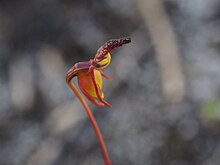| Small duck orchid | |
|---|---|

| |
| Caleana nigrita growing near Yallingup | |
| Scientific classification | |
| Kingdom: | Plantae |
| Clade: | Tracheophytes |
| Clade: | Angiosperms |
| Clade: | Monocots |
| Order: | Asparagales |
| Family: | Orchidaceae |
| Subfamily: | Orchidoideae |
| Tribe: | Diurideae |
| Genus: | Caleana |
| Species: | C. nigrita |
| Binomial name | |
| Caleana nigrita (J.Drumm. ex Lindl.) Blaxell | |
| Synonyms | |
Caleana nigrita, commonly known as the small duck orchid or flying duck orchid is a species of orchid endemic to the south-west of Western Australia. It is the most common of the flying duck orchids and has the widest distribution of the Western Australian species. It has a single smooth leaf and is distinguished from the others by its labellum which has a hump in the middle and calli covering two thirds of its outer end. Its dull colouration makes it difficult to find, especially in areas that are blackened by fire.
Description
Caleana nigrita has a single smooth green or red leaf, 10–30 mm (0.4–1 in) long and 7–11 mm (0.3–0.4 in) wide. One or two greenish-yellow and red flowers, 16–27 mm (0.6–1 in) long and 9–16 mm (0.4–0.6 in) wide are borne on a stalk 50–150 mm (2–6 in) high. The dorsal sepal, lateral sepals and petals hang downwards with the dorsal sepal pressed against the column which has broad wings, forming a bucket-like shape. Two-thirds of the outer part of the labellum is covered with glossy black glands or calli and the labellum has a small hump at its centre. Flowering occurs from August to October.
Taxonomy and naming
The small duck orchid was first formally described in 1840 by John Lindley from an incomplete description by James Drummond in Edwards's Botanical Register. Drummond had given it the name Caleana nigrita and Lindley published his description in A Sketch of the Vegetation of the Swan River Colony. In 1972 Donald Blaxell changed the name to Paracaleana nigrita but the name change has not been accepted by the World Checklist of Selected Plant Families and in 1989 Mark Clements noted that none of the characters used to separate Paracaleana from Caleana is "sufficiently significant" to maintain two genera. The specific epithet (nigrita) is a Latin word meaning "blackened".
Distribution and habitat
Caleana nigrita is found in near-coastal areas between Eneabba and Esperance in the Swan Coastal Plain, WarrenAvon Wheatbelt, Esperance Plains, Jarrah Forest and Mallee biogeographic regions where it usually grows in woodland and shrubland.
Conservation
Caleana nigrita (as Paracaleana nigrita) is classified as "not threatened" by the Western Australian Government Department of Parks and Wildlife.
References
- ^ "Paracaleana nigrita". APNI. Retrieved 12 October 2017.
- "Caleana nigrita". World Checklist of Selected Plant Families (WCSP). Royal Botanic Gardens, Kew.
- ^ Jones, David L. (2006). A complete guide to native orchids of Australia including the island territories. Frenchs Forest, N.S.W.: New Holland. p. 148. ISBN 1877069124.
- ^ Hoffman, Noel; Brown, Andrew (2011). Orchids of South-West Australia (3rd ed.). Gooseberry Hill: Noel Hoffman. p. 245. ISBN 9780646562322.
- ^ Brown, Andrew; Dundas, Pat; Dixon, Kingsley; Hopper, Stephen (2008). Orchids of Western Australia. Crawley, Western Australia: University of Western Australia Press. p. 303. ISBN 9780980296457.
- "Caleana nigrita". APNI. Retrieved 12 October 2017.
- Clements, Mark Alwyn (1989). "Catalogue of Australian Orchidaceae". Australian Orchid Research. 1: 24.
- Brown, Roland Wilbur (1956). The Composition of Scientific Words. Washington, D.C.: Smithsonian Institution Press. p. 149.
- ^ "Paracaleana nigrita". FloraBase. Western Australian Government Department of Biodiversity, Conservation and Attractions.
External links
- [REDACTED] Media related to Caleana nigrita at Wikimedia Commons
- [REDACTED] Data related to Caleana nigrita at Wikispecies
| Taxon identifiers | |
|---|---|
| Caleana nigrita | |
| Paracaleana nigrita | |